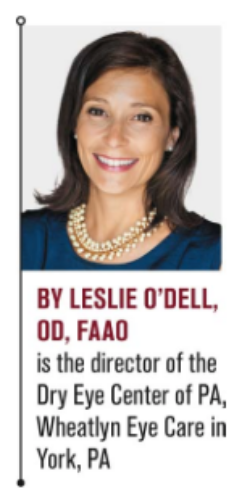How I am embracing the medical model in optometry
As we continue to grow as a profession, remember we are treating the whole patient, not just the eye alone. Incorporating lab work and imaging into your comprehensive eye care will improve patient outcomes and continue to grow your practice.


The views expressed here belong to the author. They do not necessarily represent the views of Optometry Times or UBM Medica.
With rapidly growing online sales for both eyewear and contact lenses, as well as a growing presence of online refractions, it is time for optometry to embrace our full scope of practice by focusing on the comprehensive eye exam. I am a bit biased after working many years in a medical-only practice within a MD/OD group setting-that's right, zero vision plans.
Now that I am in a group OD private practice, balancing both medical and vision plans can be frustrating. Educating patients who are “just here for glasses” to the importance of the dilated eye exam has proven to be a challenge.
We all have had the patient who is very adamant at the beginning of the exam, stating, “I am just here for my glasses and do not want any eye drops!”
Previously from Dr. O'Dell: Don’t let bad beauty habits suck the fun out of Halloween
I have had teens come in with specific instructions from their parents saying, “No dilation”
Coming from a medical-only practice in which dilation was never a question, this push back from patients has been frustrating. I can't imagine patients and parents not wanting the very best care.
My motto: Don't wait, dilate!
My favorite lifesaving story is of a patient with 20/20 visual acuity and no complaints. I detected a small choroidal melanoma during dilation, which saved her life. Recently, another patient of mine was diagnosed with a choroidal melanoma. Like the saying goes, "It's not rare if it's in your chair."
Ordering labs and imaging
Another part of embracing medical eye care was the frequency in which I ordered lab work and imaging for patients. My move to a group OD practice found that no lab slips were in the office and the doctors referred to patients’ primary-care physician (PCP) for lab work and imaging.
Flash back to my optometry school days, a favorite professor educated ODs to understand the patient as a whole body, not just the eye. A must-read book for ODs is Clinical Medicine in the Optometric Practice (Edition 1 and 2).
Related: ODs: Rulers of the Land of Presbyopia
I wanted to see what my OD peers were up to regarding ordering labs and imaging, so I turned to ODs on Facebook and asked a polling question:
Do you order blood work?
• 58 percent: No
• 22 percent: Yes
• 5 percent: Occasionally
• 15 percent: Out of scope of practice
Getting started with labs
The first step in ordering labs is having the right paperwork. This is changing with electronic medical record (EMR) systems and can be generated on a printed form for patients. If you have a system that, like mine, does not allow form generation, call your local hospital to request lab slips sent to your office. The hospital will have forms for both imaging and lab work. You can also consider using your personal Rx pad or having pre-printed Rx pads for your commonly used labs.
If using the hospital’s lab form, familiarize yourself with what is on the form. This is straightforward because the common labs are usually listed in alphabetical order. There is a space for write-in labs that ODs will often need to use. For imaging, options are grouped into the type of testing, i.e.-ultrasound, computed tomography (CT), magnetic resonance imaging (MRI), etc.
When filling out the lab form, always include the patient's PCP so he can receive a copy of the lab results. I will personally call the PCP when ordering labs in addition to sending a letter documenting what was ordered and why.
Implementing labs
Now you are ready to order labs. Here are a few examples of commonly used labs and reminders of what the labs are looking for courtesy of Patricia Fulmer, OD, from NewGradOptometry.com.
• CBC c diff: complete blood count with differential; full panel describing blood makeup (erythrocyte, leukocyte, neutrophil, plasma count, etc.)
• BMP (or Chem-8): basic metabolic panel; measures non-fasting glucose, electrolytes, and kidney function
• ESR: erythrocyte sedimentation rate; test measuring the rate at which red blood cells settle within one hour; general inflammation marker
• CRP: C-reactive protein; general inflammation marker
• HLA-B27: Human leukocyte antigen B27; presence of this antigen is indicative of the patient being at risk for or having an autoimmune disorder; the test is non-specific for which autoimmune disorder the patient may be affected
Related: The changing dry eye dynamic
• FTA-ABS: Fluorescent treponemal antibody absorption; evaluates whether or not the patient has ever had syphilis; once the patient has been infected, this test will always be positive, even after the active infection is cleared
• RPR: Rapid plasma regain; test for active syphilis; less specific than FTA-ABS, but more indicative of an active infection
• Thyroid panel (free T4, free T3, and TSH): T4=thyroxine; TSH=thyroid stimulating hormone; measures the amount of free T4 in the patient’s blood, indicative of overproduction of the main hormone produced by the thyroid gland (hyperthyroidism); measures the amount of TSH in the blood, indicative of lack of production of appropriate hormones by the thyroid gland, resulting in excess stimulating hormone (hypothyroidism)
• HbA1C: Glycosylated or glycated hemoglobin test; measurement of average glucose level over the last three months
• ANA: Antinuclear antibody; autoimmune disorder marker; non-specific
• ACE: Angiotensin-converting enzyme; elevated levels indicate likely sarcoidosis
• Lipid Panel: measures overall cholesterol, HDL, LDL, and triglyceride levels in the patient’s blood
Ordering labs may improve patient care
A 50-year-old Caucasian male presented for a routine exam with the chief complaint of decreased near vision. A dilated exam finds an isolated retinal microaneurysm OD.
He has not routinely been seen by a primary-care physician. His blood pressure was 130/70 mm Hg. In this case, initiation of labs would aid in a possible underlying systemic cause for the retinal findings. It would be recommended to order the following:
• CBC w/differential,
• Fasting blood sugar (FBS)
• Lipid panel
• HbA1C
A 45-year-old female presented with a chief complaint of one eye appearing larger than the other. The exam revealed normal extraocular muscle (EOM) function, no evidence of proptosis, and normal pupil function-however, eyelid retraction was noted OD.
No other ocular pathology was noted upon dilation. For this patient, TSH, free T4, free T3, and CBC w/diff would be recommended. It would also be recommended to image the patient with a CT of the orbits.
As we continue to grow as a profession, remember we are treating the whole patient, not just the eye alone. Incorporating lab work and imaging into your comprehensive eye care will improve patient outcomes and continue to grow your practice.
Newsletter
Want more insights like this? Subscribe to Optometry Times and get clinical pearls and practice tips delivered straight to your inbox.